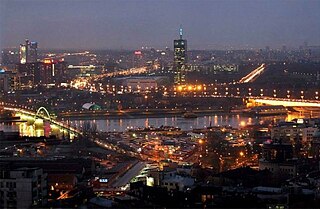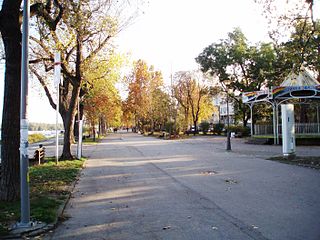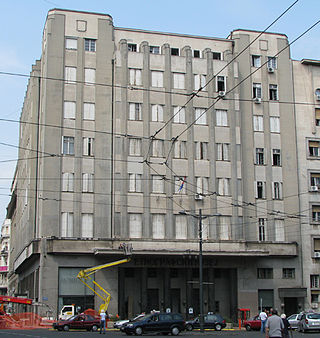
The Bajrakli Mosque is a mosque in Belgrade, the capital of Serbia. It is located in Gospodar Jevremova Street in the neighbourhood of Dorćol. It was built around 1575, and is the only mosque in the city out of the 273 that had existed during the time of the Ottoman Empire's rule of Serbia.

The Belgrade Fortress, consists of the old citadel and Kalemegdan Park on the confluence of the Sava and Danube rivers, in an urban area of modern Belgrade, Serbia. Located in Belgrade's municipality of Stari Grad, the fortress constitutes the specific historical core of the city. As one of the most important representatives of Belgrade's cultural heritage, it was originally protected right after World War II, among the first officially declared cultural monuments in Serbia. The fortress was declared a Monument of Culture of Exceptional Importance in 1979, and is protected by the Republic of Serbia. It is the most visited tourist attraction in Belgrade, with Skadarlija being the second. Since the admission is free, it is estimated that the total number of visitors is over 2 million yearly.

New Belgrade is a municipality of the city of Belgrade. It was a planned city and now is the central business district of Serbia and South East Europe. Construction began in 1948 in a previously uninhabited area on the left bank of the Sava river, opposite old Belgrade. In recent years, it has become the central business district of Belgrade and its fastest developing area, with many businesses moving to the new part of the city, due to more modern infrastructure and larger available space. With 209,763 inhabitants, it is the second most populous municipality of Serbia after Novi Sad.

Great War Island is a river island in Belgrade, capital of Serbia. It is located at the confluence of the Sava and Danube rivers. Though uninhabited, the island is part of the Belgrade City proper, and belongs to the city municipality of Zemun.

Ušće is an urban neighborhood of Belgrade, the capital of Serbia. It is located in Belgrade's municipality of Novi Beograd. Ušće is located on the mouth of the Sava river into the Danube, thus the name. It occupies Novi Beograd's Blocks 10, 13, 14, 15 and 16 on the Sava's left and the Danube's right bank, covering a tip of land that overlooks the islands of Little War Island and Great War Island to the north and the old core of Belgrade, the fortress of Kalemegdan to the west. Ušće borders the neighborhoods of Staro Sajmište and Savograd on the south. As a compact grassy and forested area it stretches along the bank of the Danube into the Block 10, to the Zemun municipality and the Hotel Jugoslavija and the ENJUB shopping mall.
Kožara is a river island (ada) in Serbia, located on the left bank of the Danube. It is part of the Belgrade City proper and belongs to the Belgrade's municipality of Palilula.
Čaplja is a projected river island (ada) in Serbia, on the left bank of the Danube. According to the General Urbanistic Plan (GUP) of Belgrade, it will be formed in Belgrade's municipality of Palilula.

Little War Island or Malo ratno ostrvo or Horse Island or Konjsko ostrvo is a river island (ada) in Serbia, located at the mouth of the Sava river into the Danube. It is part of the Belgrade City proper, the capital of Serbia, and belongs to the municipality of Zemun.

Zemunski Kej is an urban neighborhood of Belgrade, the capital of Serbia. It is located in Belgrade's municipality of Zemun.

The Ethnographic Museum is a museum located in Belgrade, the capital of Serbia. It is one of the oldest museums in the Balkans. The Ethnographic Museum in Belgrade fulfills its mission together with the efforts of various stakeholders in the domain of presentation, revitalization and development of crafts in Serbia.

The Kalemegdan Park, or simply Kalemegdan is the largest park and the most important historical monument in Belgrade. It is located on a 125-metre-high (410 ft) cliff, at the junction of the River Sava and the Danube.

The Eternal Flame is a memorial in the Park of Friendship in Belgrade, Serbia. It is dedicated to the military and civilian casualties resulting from the NATO bombing of Yugoslavia in 1999 and symbolizes the resistance of the Serbian nation to the attack.
The siege of Braničevo was laid by Hungarian king Géza II against Byzantine-held Braničevo in late 1154.

Air Force Headquarters is the monumental edifice, situated at 12 Aviatic Square in Zemun, Belgrade, the capital of Serbia.

House of Dimitrije Živadinović is located in Belgrade, in the territory of the city municipality of Stari Grad. It was built in 1904 and represents immovable cultural property as a сultural monument.

The Serbian Journalists' Association Building is in Belgrade, in the territory of the city municipality of Vračar. It was built in 1934, and it represents an immovable cultural property as a cultural monument.

Faculty of Law Building in Belgrade is at 67 Boulevard of Kralj Aleksandar. A work of architectural – urban value, as well as an angular building, built in accordance with the modernist concept, which significantly expands articulates the wider space, as the first building built solely for the purposes of the Faculty of Law, one of the oldest institutions of higher education in Serbia, also has cultural and historical value. The building of the Faculty of Law was declared a cultural monument.

Memorial Museum of Nadežda and Rastko Petrović is a memorial museum located in Belgrade, the capital of Serbia. It was declared a cultural monument in 1974 by the decision of the Institute for the Protection of Cultural Monuments from 1974.

Seismological Institute Building (Serbian: Зграда Сеизмолошког завода, Zgrada Seizmološkog zavoda is located in Tašmajdan, park in Belgrade, the capital of Serbia. Built and adapted from 1908 to 1939, it was the first public building in this part of Belgrade and the first work of architect Momir Korunović, who later projected some of the most beautiful Belgrade buildings during the Interbellum and was nicknamed "Serbian Gaudi". It has been declared a cultural monument in 2007.
Grigorije Ivanovič Samojlov(Russian Cyrillic: Григорий Иванович Самойлов; Taganrog, Imperial Russia, 8 September 1904 - Belgrade, Serbia, Yugoslavia, 15 October 1989) was a Russian architect, designer and painter who lived and worked in Serbia. He was one of the many academically trained Russian émigrés who after settling in Serbia contributed the architectural landscape of the Kingdom of Serbs, Croats and Slovenes. He built in the spirit of academism, Serbo-Byzantine style, modernism and art deco. He distinguished himself not only with his high skills in designing various types of building, from monumental public buildings to family houses, but also as the author of some of the most beautiful interiors of Belgrade palaces of this period. Also, he painted the likenesses of King Alexander I of Yugoslavia, and scientist Milutin Milanković among the most notable, as well as teaching the art of design and painting.






















